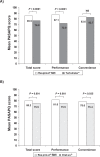Patient preferences for inhaler devices in chronic obstructive pulmonary disease: experience with Respimat Soft Mist inhaler
- PMID: 19888356
- PMCID: PMC2829861
- DOI: 10.2147/copd.s3391
Patient preferences for inhaler devices in chronic obstructive pulmonary disease: experience with Respimat Soft Mist inhaler
Abstract
Current guidelines for the management of chronic obstructive pulmonary disease (COPD) recommend the regular use of inhaled bronchodilator therapy in order to relieve symptoms and prevent exacerbations. A variety of inhaler devices are currently available to COPD patients, and the choice of device is an important consideration because it can influence patients' adherence to treatment, and thus potentially affect the long-term outcome. The Respimat((R)) Soft Mist Inhaler (SMI) generates a slow-moving aerosol with a high fine particle fraction, resulting in deposition of a higher proportion of the dose in the lungs than pressurized metered-dose inhalers (pMDIs) or some dry powder inhalers (DPIs). We review clinical studies of inhaler satisfaction and preference comparing Respimat((R)) SMI against other inhalers in COPD patients. Using objective and validated patient satisfaction instruments, Respimat((R)) SMI was consistently shown to be well accepted by COPD patients, largely due to its inhalation and handling characteristics. In comparative studies with pMDIs, the patient total satisfaction score with Respimat((R)) SMI was statistically and clinically significantly higher than with the pMDI. In comparative studies with DPIs, the total satisfaction score was statistically significantly higher than for the Turbuhaler((R)) DPI, but only the performance domain of satisfaction was clinically significantly higher for Respimat((R)) SMI. Whether the observed higher levels of patient satisfaction reported with Respimat((R)) SMI might be expected to result in improved adherence to therapy and thus provide benefits consistent with those recently shown to be associated with sustained bronchodilator treatment in patients with COPD remains to be proven.
Keywords: Respimat® Soft Mist™ Inhaler; inhaler devices; pressurized metered-dose inhalers.
Figures


References
-
- Calverley PM. Inhaled corticosteroids are beneficial in chronic obstructive pulmonary disease. Am J Respir Crit Care Med. 2000;161:341–342. - PubMed
-
- Global Initiative for Chronic Obstructive Lung Disease (GOLD) Bethesda: National Institute of Health, National Heart, Lung, and Blood Institute; 2003. Global Strategy for the diagnosis, management and prevention of chronic obstructive pulmonary disease. NHLBI/WHO Workshop Report. - PubMed
-
- Sin DD, McAlister FA, Man SF, et al. Contemporary management of chronic obstructive pulmonary disease: scientific review. JAMA. 2003;290:2301–2312. - PubMed
-
- Celli BR, Thomas NE, Anderson JA, et al. Effect of Pharmacotherapy on Rate of Decline of Lung Function in Chronic Obstructive Pulmonary Disease: Results from the TORCH Study. Am J Respir Crit Care Med. 2008;178(4):332–338. - PubMed
Publication types
MeSH terms
LinkOut - more resources
Full Text Sources
Medical

